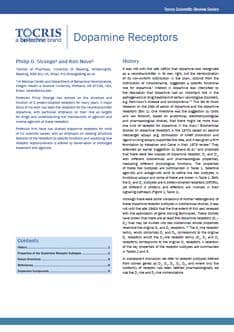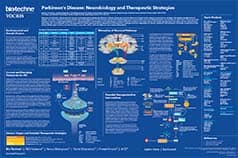Vesicular Monoamine Transporters
VMAT (Vesicular Monoamine Transporters) transport biogenic amines such as dopamine into vesicles within monoamine-containing neurons. This activity aids neurotransmission and helps maintain cytoplasmic neurotransmitter concentrations.
Vesicular Monoamine Transporter Inhibitors |
|
|---|---|
| Cat. No. | Product Name / Activity |
| 2742 | Reserpine |
| Inhibitor of vesicular monoamine transport | |
| 2175 | Tetrabenazine |
| Potent inhibitor of vesicular monoamine transport | |
Other |
|
| Cat. No. | Product Name / Activity |
| 5200 | FFN 102 mesylate |
| Selective fluorescent substrate of VMAT2 and DAT | |
| 5911 | FFN 200 dihydrochloride |
| Selective fluorescent VMAT2 substrate | |
| 5043 | FFN 206 dihydrochloride |
| Fluorescent VMAT2 substrate | |
| 6717 | FFN 270 |
| Fluorescent substrate for NET and VMAT2 | |
VMATs (Vesicular Monoamine Transporters) transport biogenic amines such as dopamine into vesicles within monoamine-containing neurons. Vesicular transporters are responsible for filling synaptic vesicles with neurotransmitter, thus contributing to the recycling of neurotransmitter and ensuring neurotransmission throughout the CNS.
There are four known vesicular transporters:
- VMAT1 and VMAT2 (vesicular monoamine transporters), which transport biogenic amines
- VAChT (vesicular acetylcholine transporter)
- VGAT (vesicular GABA and glycine transporter)
- VGLUT 1, VGLUT2 and VGLUT3 (vesicular glutamate transporters)
VMAT exists as two isoforms - VMAT1 and VMAT2 - which are distributed between different cell types. VMAT1 is generally expressed in neuroendocrine cells while VMAT2 is usually active in serotonergic, dopaminergic, histaminergic and adrenergic neurons. The function of VMAT is not only important for the maintenance of neurotransmission, but also serves a protective purpose: keeping the cytoplasmic concentrations of neurotransmitters low in order to avoid oxidative deamination and toxicity. VMAT2 has been shown to sequester MPP+, the toxic metabolite of MPTP, in synaptic vesicles. VMAT2 is also the only transporter that moves cytoplasmic dopamine into vesicles and this makes it an attractive therapeutic target for both Parkinson's disease and Huntington's disease.
External sources of pharmacological information for Vesicular Monoamine Transporters :
Literature for Vesicular Monoamine Transporters
Tocris offers the following scientific literature for Vesicular Monoamine Transporters to showcase our products. We invite you to request* your copy today!
*Please note that Tocris will only send literature to established scientific business / institute addresses.
Dopamine Receptors Scientific Review
Written by Phillip Strange and revised by Kim Neve in 2013, this review summarizes the history of the dopamine receptors and provides an overview of individual receptor subtype properties, their distribution and identifies ligands which act at each receptor subtype. Compounds available from Tocris are listed.
Parkinson's Disease Poster
Parkinson's disease (PD) causes chronic disability and is the second most common neurodegenerative condition. This poster outlines the neurobiology of the disease, as well as highlighting current therapeutic treatments for symptomatic PD, and emerging therapeutic strategies to delay PD onset and progression.
Vesicular Monoamine Transporter Gene Data
| Gene | Species | Gene Symbol | Gene Accession No. | Protein Accession No. |
|---|---|---|---|---|
|
SLC18A1 (VMAT1) |
Human | SLC18A1 | NM_001135691 | P54219 |
| Mouse | Slc18a1 | NM_153054 | Q8R090 | |
| Rat | Slc18a1 | NM_013152 | Q01818 | |
|
SLC18A2 (VMAT2) |
Human | SLC18A2 | NM_003054 | Q05940 |
| Mouse | Slc18a2 | NM_172523 | Q8BRU6 | |
| Rat | Slc18a2 | NM_013031 | Q01827 |

